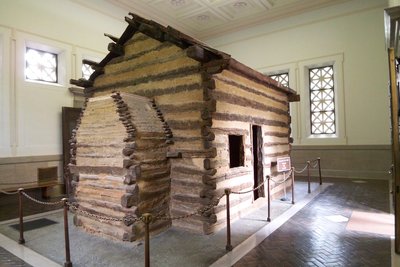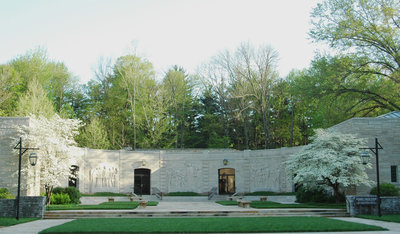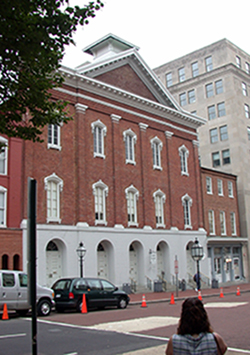
Film puts Lincoln historic sites in spotlight
Steven Speilberg’s latest blockbuster “Lincoln” has been in headlines for months, most recently for winning two Academy Awards including best actor.
This film helped refocuses our nation’s attention on one of our most significant Presidents at a most opportune time: 2013 marks the 150th anniversary of the Emancipation Proclamation and 2015 marks the 150th anniversary of Lincoln’s assassination. Both of which are substantial elements in the nine-figure grossing flick.
An excellent way to commemorate Lincoln’s memory is by visiting any of the dedicated 33 state, historic, and national sites that are scattered across our country. Six of these locations are National Historic Sites (NHS), including the Abraham Lincoln Birthplace NHS, Lincoln Boyhood National Memorial, and Ford’s Theatre NHS. Additionally, one could visit Fort Jefferson at Dry Tortugas National Park where Dr. Samuel Mudd – a conspirator of John Wilkes Booth – was jailed following his involvement with the assassination.
Abraham Lincoln Birthplace NHS
On Feb. 12, 1809, parents Thomas and Nancy Lincoln welcomed son Abraham into the world in their one-room log cabin at Sinking Spring Farm in Hodgenville, Ky. The Lincoln family spent the next two years in this cabin until they were forced to move to nearby Knob Creek Farm due to Thomas’ issues with land titles. After leaving Sinking Spring Farm, the Lincolns moved a few miles north to Knob Creek.
 |
The log cabin at Abraham Lincoln Birthplace National Historic Site (Photo courtesy of the National Park Service). |
Abraham Lincoln’s earliest memory was from Knob Creek: the neighbor’s son saved Lincoln from drowning in the creek.
Unfortunately, the Sinking Spring cabin was dismantled sometime before 1865. There are rumors that the logs were subsequently used to create a neighboring home and that they were later purchased by businessman A.W. Dennett who reconstructed the cabin. Dennett supposedly sold the logs to the Lincoln Farm Association, which then used them to erect a replica symbolic of the Lincoln’s original log cabin. However, these rumors have been largely refuted. The “symbolic cabin is from the time period of the original Lincoln cabin and is housed in a large memorial building” said Ranger.
Both sites are now a part of the Abraham Lincoln Birthplace National Historic Park and managed by National Park Service. At the Sinking Spring site, visitors are able to experience both the Lincoln Memorial Building and log cabin. Clearly, the draw of this site is being able to see where our nation’s 16th president, responsible for ending slavery and leading our nation through its only Civil War, was born.
The site also offers an audiovisual presentation and exhibition hall in the Visitor’s Center. Ranger explains the film is “a 15 minute movie about Lincoln’s life in Kentucky [and] we have an exhibit hallway which has the original [Lincoln} family bible”. Plus tourists can see the Sinking Spring from which the Lincoln’s drew their water more than 200 years ago. The Knob Creek site, added to the park in 1999, features a 19th century log cabin believed to have belonged to a neighbor and a historic 20th century tavern and tourist site.
Lincoln Boyhood National Memorial
After having more issues with land titles, the Lincolns moved to Little Pigeon Creek, Ky., in 1816. Now named the Lincoln Boyhood National Memorial, this NPS managed location is home to a memorial building, exhibition hall and a historical farm. The memorial building is made of limestone ashlar and has a small theatre that plays a 15-minute film about Lincoln’s life. The memorial also features several exhibits and artifacts related to Lincoln’s life, Lincoln related artwork, and an oil painting of Nancy Hanks Lincoln. There is also a chapel and meeting hall that can be rented for private weddings or other gatherings.
 |
Lincoln Boyhood National Memorial (Photo courtesy of the National Park Service). |
One of the site’s main attractions is the historical farm nearby where archaeologists have unearthed the original Lincoln cabin that has since been preserved and is protected by a wall. Nearby is the replica of the farmhouse and the Living Historical Farm where park rangers in full period clothing work the farm. “The historical farm isn’t a strict recreation of the Lincoln farm, it’s something that is representative of the time period in which they were here” said Park Ranger Mike Capps. The farm is open seasonally (April-September) and cultivates crops and raises livestock.
Each February the site hosts Lincoln Day where around “100 to 150 people come to see guest speakers and hear special music [in celebration of Lincoln’s life]” said Capps. This year they featured the Emancipation Proclamation in celebration of the 150th anniversary.
Ford’s Theatre and Peterson House
On April 14, 1865 actor John Wilkes Booth shot Abraham Lincoln during a performance of “Our American Cousin” at Ford’s Theatre. The shooting came a mere five days after the Confederacy surrendered to the Union and ended the Civil War. After shooting the President, Booth famously shouted sic semper tyrannis, or death to tyrants, and escaped outside the stage’s the backdoor. The president was a regular patron of the theatre, this being his 12th show. Lincoln died the next morning at the Peterson House, a boarding house across the street.
 |
The exterior of Ford’s Theatre National Historic Site in Washington, D.C. (Staff Photo). |
Ford’s Theatre remained closed as a theatre after the shooting for more than 100 years until its 1968 reopening. The theatre was again renovated during a 2009 remodeling and expansion, including the addition of a basement museum illuminating the world of the Civil War, Washington D.C., and the years of Lincolns’ presidency. University of Miami student Annie Kantelis visited the remodeled theatre, “it was an out of body experience to be in the same spot where my favorite president was shot. All the renovations made me feel like I was in the theatre back in the 1860s.” In 2012 A Center for Education and Leadership was added to the theatre.
Today, Ford’s Theatre National Historic Site offers visitors many ways to honor President Lincoln’s memory: the Ford’s Theatre Lincoln medal, which is awarded to an individual who exemplifies the characteristics Lincoln embodied himself (i.e. Morgan Freeman, Elie Wiesel); the Lincoln Legacy Project, which aims to create a conversation about issues like tolerance and equality in Washington D.C. through theatrical programs and educational series; and the Lincoln Leadership Exhibition, which examines Lincoln’s most important leadership ideals and how they are relevant today.
Fort Jefferson at Dry Tortugas National Park
Fort Jefferson is located about 70 miles west off the coast of Key West and served as a military and civilian prison during the Civil War era. Most of the fort’s prisoners were guilty of inconsequential crimes like military desertion and theft. The fort’s four most famous prisoners, Mudd, Spangler, Arnold, and O’Laughlen, were each convicted of conspiring with Booth in the assassination of President Lincoln.
The most famous of the four is Dr. Samuel Mudd, who attended to the leg Booth broke while escaping from Ford’s Theatre. The doctor claimed to have never met John Wilkes Booth before and that he believed he was merely helping an injured stranger. However, the evidence was stacked up against Mudd and he was sent to prison in Florida. At Fort Jefferson, Mudd is remembered for his early escape attempt and for serving as the fort’s doctor during a breakout of yellow fever.
| Fort Jefferson in Dry Tortugas National Park (Photo courtesy of the National Park Service). |
Interpretive ranger Mike Ryan explained, “four hundred people were living out here…there were 278 cases of yellow fever. That’s pretty serious. Thirty-eight died that we know of. Even if you hate Dr. Mudd, you’ve got to respect what he did during the epidemic.” Two years after the yellow fever outbreak President Johnson pardoned Mudd and he returned home in Bryantown, Md.
Today visitors can get to Fort Jefferson by taking a two-hour ferry trip from Key West. Visitors can take a walking ranger-guided tour of Fort Jefferson, a self-guided tour, or a boat tour. Included in the tour is Mudd’s cell in the “dungeon,” where he was brought after attempting to escape. The boat tours also offer fishing, diving, and snorkeling around wildlife and the famous Windjammer sailboat wreck site.
These are only a few of the sites associated with Abraham Lincoln. Try and get out to one of these parks this year to celebrate the 150th anniversary of the Emancipation Proclamation. Find out if you’re nearby one of the other 30 or so sites on the park service website at http://www.nps.gov.

Comments are Closed